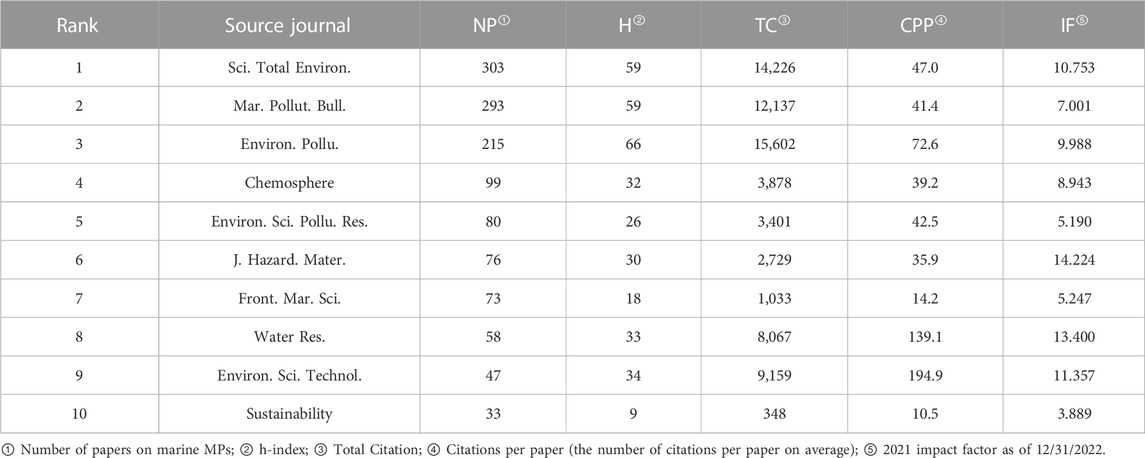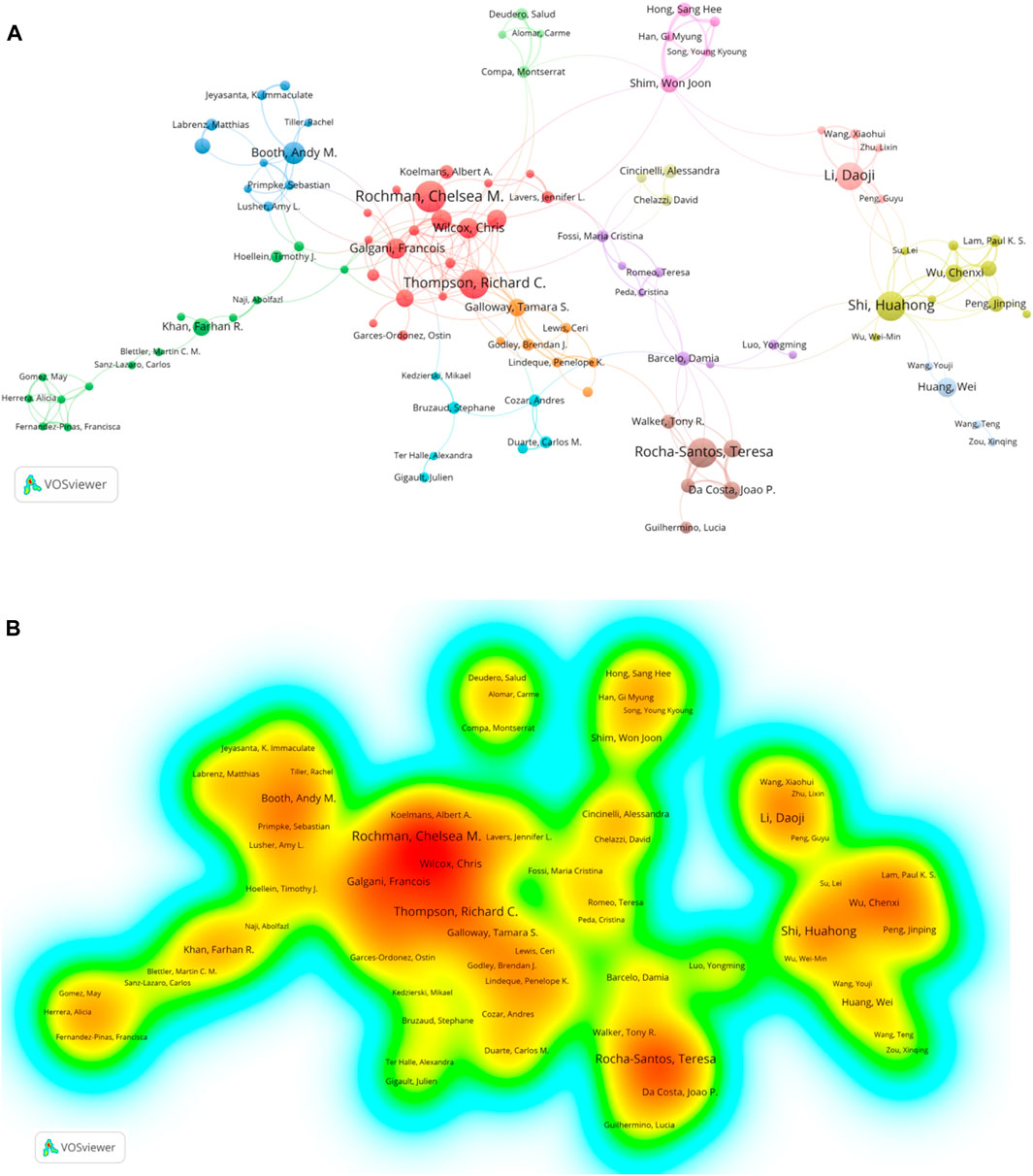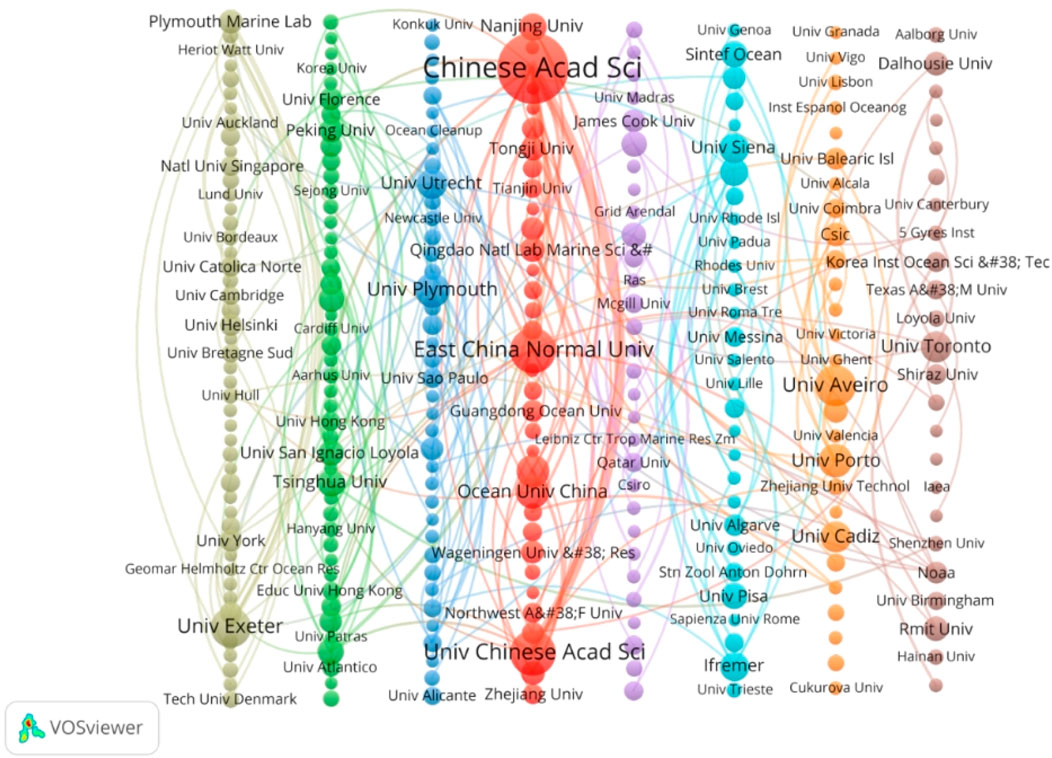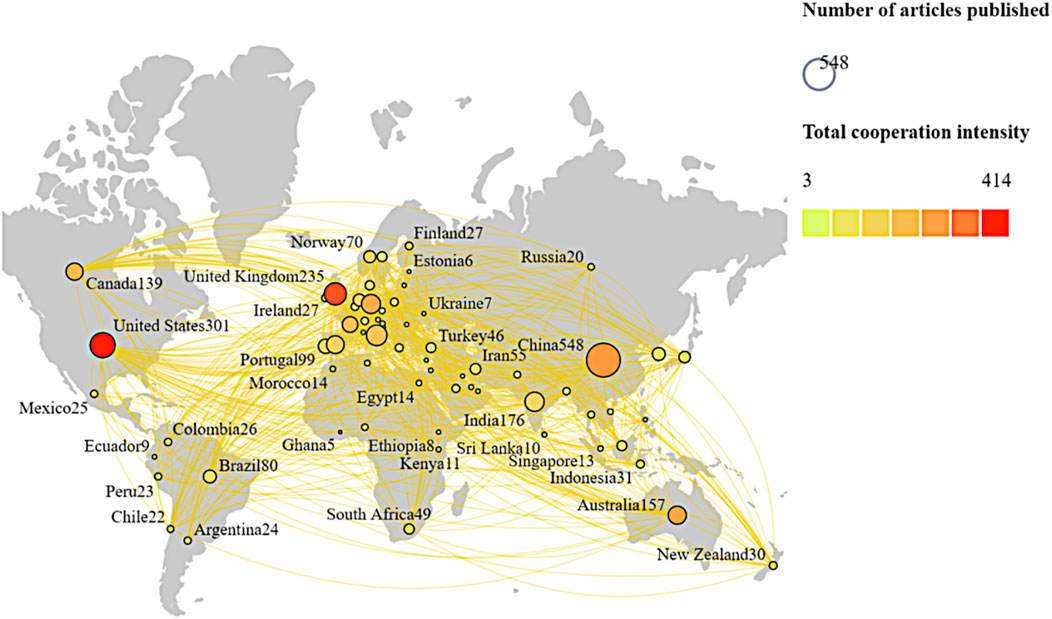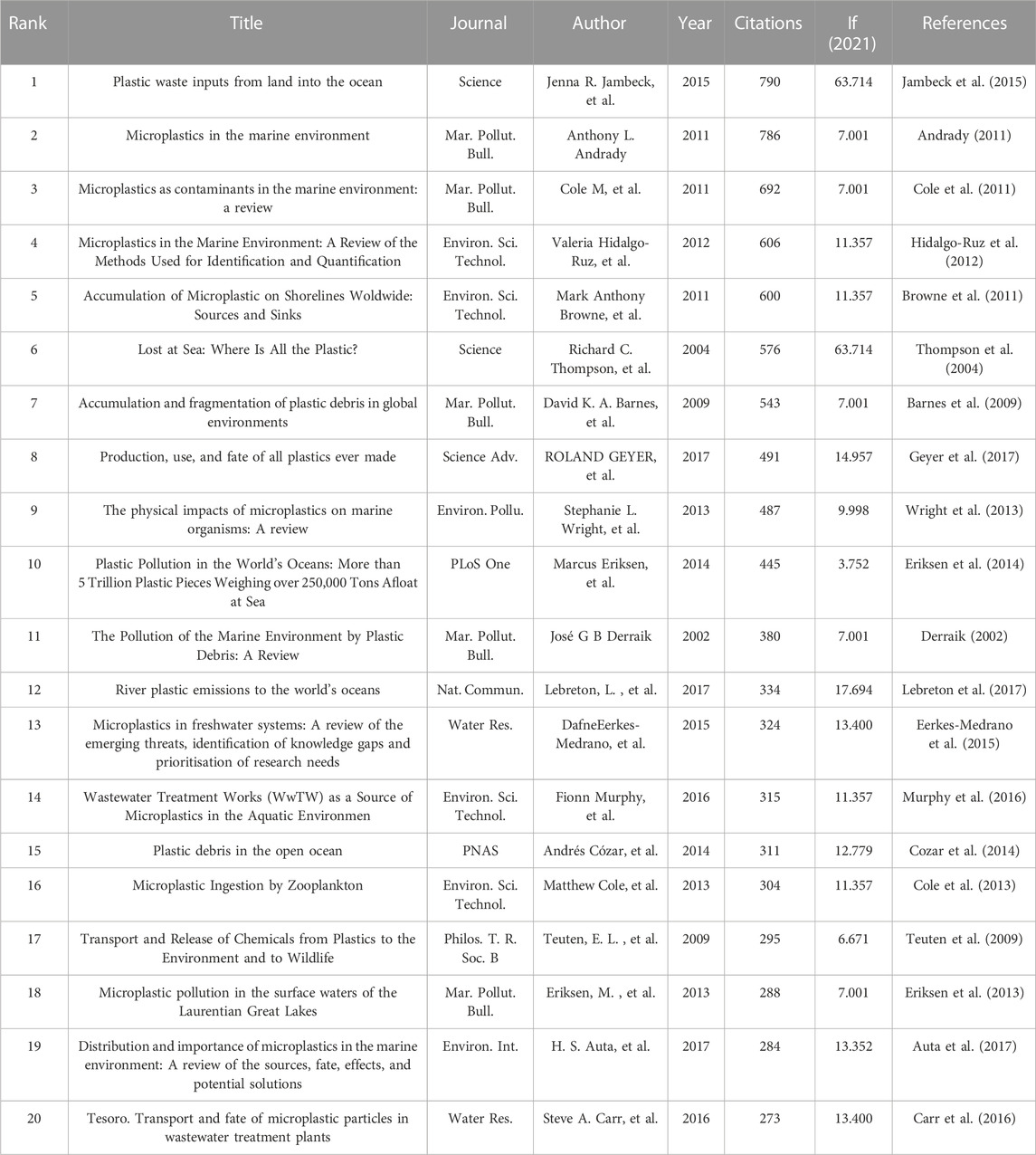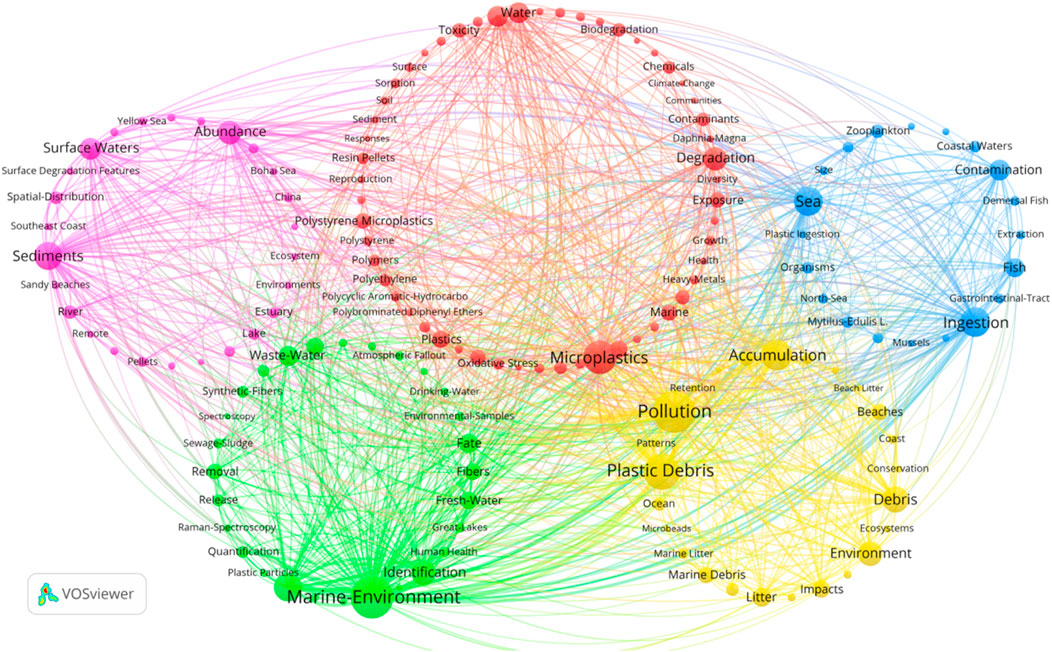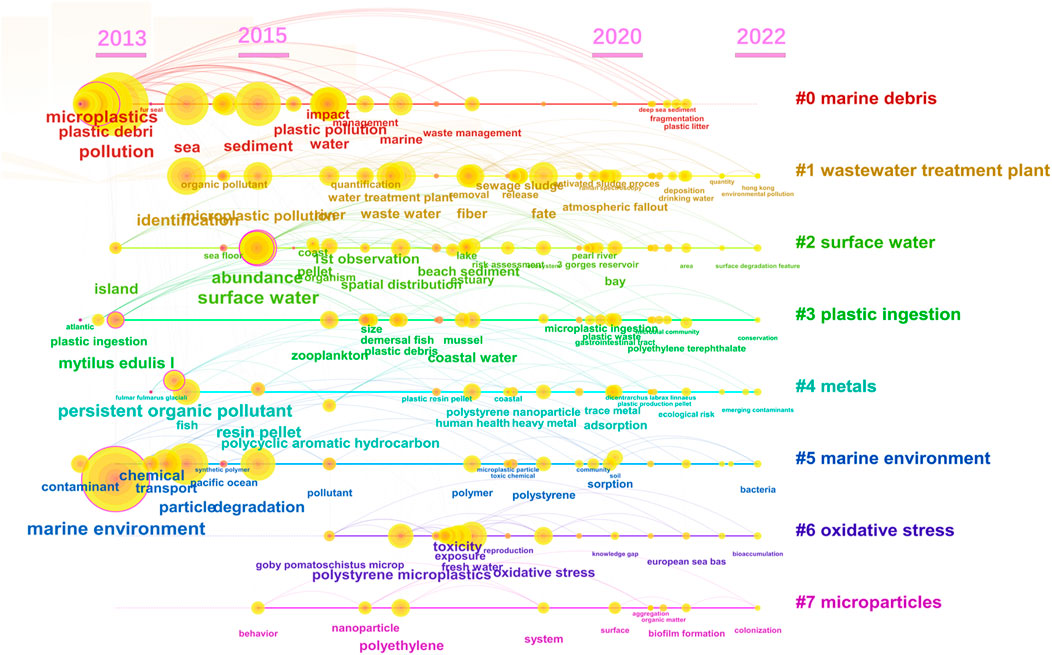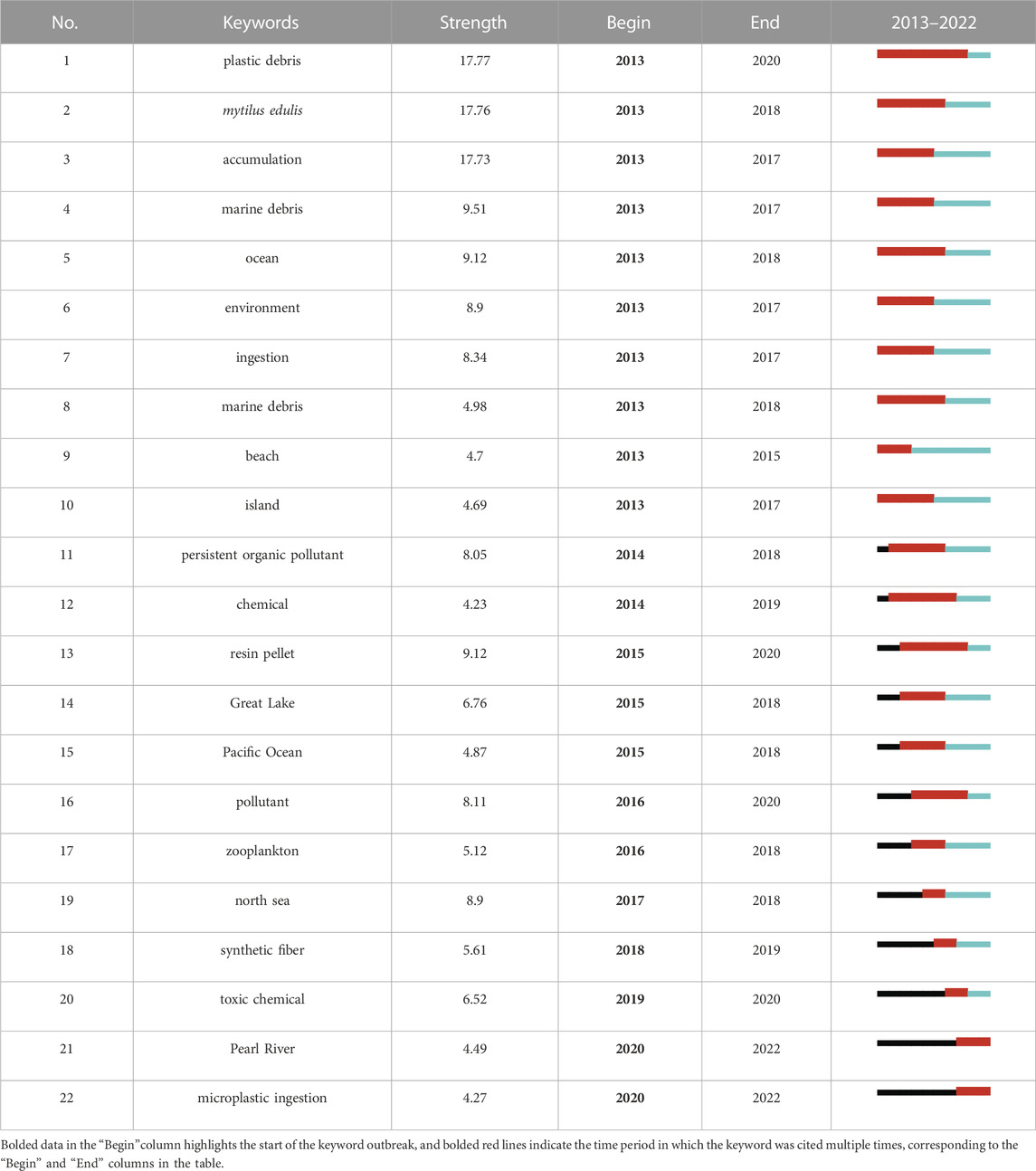- 1Laboratory of Quality Safety and Processing for Aquatic Product, East China Sea Fisheries Research Institute, Chinese Academy of Fishery Sciences, Shanghai, China
- 2Shanghai Collaborative Innovation Centre for WEEE Recycling, School of Resources and Environmental Engineering, Shanghai Polytechnic University, Shanghai, China
The control of microplastic pollution in the marine environment has become a growing public concern in recent years. To better grasp the trends and development of microplastic pollution control in the marine environment, the published literature in Science Citation Index Expanded (SCIE) database of Web of Science Core Collection from 2013 to 2022, up to a total of 2,357 articles or reviews was analyzed through CiteSpace and VOSviewer tools. The results show an exponential growth in the number of papers related to the control of microplastic pollution in the marine environment, with China, United States, India, and Australia providing the main drivers, while China being the most active country, with Science of the Total Environment, Marine Pollution Bulletin, Environmental Pollution and Chemosphere being the most important sources for publishing relevant research. A relatively complete theoretical framework has been developed for the control of marine microplastic pollution, focusing on the quantification, traceability and collectability of microplastics. However, few papers have focused on policy implications and technological innovations in this area. The research on marine microplastic pollution control has transitioned from traceability and hazard analysis of microplastics to the impact of economic activities and synthetic fibre on microplastic pollution. Microplastics in wastewater discharged from municipal wastewater treatment plants, human consumption, man-made fibers and synthetic polymers have become the frontier of research. The present study is of significance for better understanding and supporting further research on the control of microplastic pollution in the marine environment.
1 Introduction
The largest and most persistent portion of marine litter is synthetic polymers and thermosets, collectively known as plastics. (Law, 2017) Marine plastic pollutants account for at least 85% of total marine waste. (Agamuthu et al., 2019) The United Nations Environment Programme (UNEP) has indicated that the amount of marine litter and plastic pollution has been growing rapidly. Under a business-as-usual scenario and in the absence of necessary interventions, the amount of plastic waste entering aquatic ecosystems could nearly triple from some 9–14 million tons per year in 2016 to a projected 23–37 million tons per year by 2040. Other researchers predicted the amount of plastic waste is approximately double with 19–23 million tons per year in 2016 and around 53 million tons per year by 2030. (Irene Samy Fahim and Landrigan, 2021).
The plastics can be broadly classified into four classes, i.e., nanoplastics, microplastics (MPs), mesoplastics, macroplastics, with dimensions <0.001 mm, <5 mm, <25 mm, and >25 mm, respectively. (Shim et al., 2018). In recent years, MPs have become a growing concern because of the harm they cause to marine organisms and marine ecology. (Basili et al., 2020). Land-based sources are considered to be the main source of MPs entering the ocean, with two pathways, i.e., primary and secondary MPs. The former come from engineered MP beads and industrially produced plastic powders widely used in cosmetic formulations (Castaeda et al., 2014; Napper et al., 2017) and abrasives, and also include fibers released during the manufacture of synthetic textiles and clothing (Salvador Cesa et al., 2017). These MPs are barely visible to the naked eye, and are likely to flow directly from bathroom drains or industrial discharges into the drainage system, easily escaping capture by sewage treatment plants and eventually entering the aquatic environment. The latter comes primarily from large plastic debris that enters the marine environment directly from shorelines, rivers and sewage pipes through a combination of physical (mechanical), chemical (photolytic) and biological processes when exposed to high levels of solar UV radiation and mechanical wear and tear. (Jiajia et al., 2018) MPs in the ocean not only damage the health of marine species, but also affect the carbon cycle in the ocean by altering the transfer of carbon to the deep sea, (Wieczorek et al., 2019) which further affects marine ecosystems.
MPs have a profound impact on marine ecology (Lusher et al., 2013; Tanaka et al., 2013; Seltenrich, 2015) and even on the mainland environment (Lönnstedt and Eklöv, 2016). They affect marine organisms through uptake and ingestion, resulting in physiological and behavioral effects. The transformation of MPs through the food chain leads to bioaccumulation, which affects the stability of the entire ecosystem. In addition, the accumulation and deposition of MPs can lead to changes in the seabed and the destruction of benthic habitats. Taken together, these ecological problems have widespread and long-term effects on the marine ecosystem, threatening marine biodiversity, ecological balance and the sustainable use of marine resources. Analyzing the current state of this area is therefore crucial. Bibliometrics is an interdisciplinary discipline that uses mathematical and statistical methods to analyse literature data and is a powerful tool for studying the current state of a field and future research trends. Firstly, it identifies research hotspots, enabling targeted resource allocation for more effective problem solving. Secondly, it highlights emerging frontiers for potentially high-impact research, promoting innovative technologies and strategies. It also informs the development of policy and management strategies, helping governments and environmental agencies to develop effective regulations and practices. Finally, it identifies knowledge gaps and directs researchers to areas that need further investigation, thereby contributing to the advancement of knowledge in the field. Overall, bibliometric analysis enhances research direction, policy formulation and knowledge expansion in the field of marine MP pollution control.
This study quantitatively analyzes the relevant literature in the scope by using statistical and mathematical analysis through software packages such as VOSviewer. With the advantage of its objective and quantitative macroscopic research, literature data such as titles, authors, institutions, journals, keywords, and references are processed to generate citation networks, co-occurrence networks, and coupling networks. The following is a comprehensive analysis of publication trends, source journal analysis, author contributions and collaborations, keyword co-occurrence analysis, co-citation analysis, and research frontiers and hotspots. Further visual analysis of the evolution of research hotspots and frontiers of marine MP pollution treatment in the last decade provides new insights into marine MP pollution control.
2 Data and methods
2.1 Data retrieval
The Web of Science Core Collection (WoSCC) was selected as the data source for this study. Valuable scientific information and a comprehensive understanding of this field can be acquired conveniently using the powerful search function of WoSCC. (Ying et al., 2023).Scope of research selection with “topic” (TS) as the search field and refined in the Advanced Search module of WoSCC database with the search formula: TS = (microplastic OR microplastics OR “plastic debris” OR micro-plastic OR nanoplastics) AND TS = (marine OR sea OR ocean OR beach OR bay OR gulf OR estuary OR coastline OR shoreline) AND TS = (contamination OR pollution OR contaminate OR pollute OR stain OR filth OR contaminant OR foul) AND TS = (removal OR removal OR removed OR remove OR exenterate OR dispose OR expulsion OR erasing OR eliminate OR degradation OR degrade OR decomposition OR decompose OR degeneration OR hydrolysis OR degradable OR dissipation OR harness OR governance OR treatment OR control OR management OR government OR govern OR administration OR regulation). In addition, the language is further limited to English, and the document type is restricted to “article” and “review”. To collect relevant papers from the last decade, the search was set to span from 01/01/2013 to 12/31/2022. Finally, the research directions and topics of all publications were reviewed to remove irrelevant content, such as “Food Science & Technology, Political Philosophy,” resulting in a total of 2,357 relevant papers written by 10,074 authors from 408 countries, spanning 6,840 institutions and published in 394 journals.
2.2 Methods
Bibliometrics is an interdisciplinary discipline that uses mathematical and statistical methods to analyze data from the literature collected from the WoS core repository, including number of publications, authors, institutions, countries/regions, citations, etc., through tabulation and visual mapping. (Shiffrin and Boerner, 2004) CiteSpace and VOSviewer are the most commonly used bibliometric tools among various software. Using VOSviewer, visual collaboration graphs based on the collaboration between elements such as countries, institutions, authors, etc., can be displayed in three dimensions. (van Eck and Waltman, 2010; Pan et al., 2018) CiteSpace is a data analysis and visualization software based on set theory with a special focus on the temporal dimension, allowing the analysis of time slices through timeline analysis to further explore trends in the field. Reference co-citation knowledge domain maps and keyword timelines were created using the CiteSpace software package (Chen, 2006).
VOSviewer and CiteSpace assign each node in the network to a class cluster—a class cluster is a set of closely related nodes assigned according to a specific connectivity metric (e.g., co-citation, bibliographic coupling, etc.). These clusters are classified by the software based on the clustering algorithms built into the software, e.g., Likelihood Ratio (LLR) clustering algorithm and Latent Semantic Indexing (LSI), where the nodes are knowledge bases and the labels are taken from the literature at the forefront of research. Unfortunately, we are not fully aware of the logic behind the software’s clustering algorithms, and have only analysed and discussed the results based on those derived from the software, and therefore have not discussed the division of the clusters further. VOSviewer and CiteSpace allow researchers to apply filters. We can zoom in on a certain part of the data, e.g., focusing on authors or organisations with at least 5 articles. In order to visualise the main contributions to the literature on the control of marine microplastic pollution, we have used filters, as detailed in the information below. In the course of this study, authors with 5 or more publications were selected for analysis in the author analysis, generating a total of 146 nodes. In the organizational analysis, organizations with 5 or more articles were selected for analysis, generating a total of 276 nodes. For the country analysis, countries with at least five articles were selected for analysis based on the first author assigning the article to a country, where Northern Ireland, Wales and Scotland were merged to form the United Kingdom and China included Taiwan, resulting in a total of 66 nodes. For the literature co-citation analysis, literature with a minimum of 200 citations was selected, resulting in a total of 66 nodes. Among the 394 journals obtained, those with no less than 100 citations to cited journals were selected for co-citation analysis, resulting in a total of 154 nodes. A total of 3,160 keywords were extracted from the Web of Science core database. Keywords with more than 20 occurrences were selected for visual analysis, resulting in a total of 153 keyword nodes. In addition, the “Top 22 Keywords with the Strongest Citation Bursts” and “Keyword timeline” were analyzed by the software Citespace.
3 Results and discussion
3.1 Yearly quantitative distribution of the literature
The statistical analysis of the number of publications in the decade 2013 to 2022 provides a clear picture of trends in scientific output and the ongoing development and maturation of marine MP research field. The distribution of research outputs on the control of MP pollution in the ocean based on time series is shown in Figure 1. From 2013 to 2017, the number of articles related to marine MP pollution control grew slowly, with less than 100 articles published in 2017. However, there was a large increase in 2018 and 2019, with annual publication volumes of 198 and 245, respectively, and the research related to marine MP pollution control gradually became a hot spot, which cannot be separated from the UNEP guidance and related policies in several countries. (Xanthos and Walker, 2017) From 2020 onwards, there is a sudden increase in published articles, with 1,686 articles related to the topic published in the last 3 years (2020–2022), accounting for 71.53% of the overall number of articles published in the last decade. This indicates that the MP issue is gaining dramatic attention from researchers, especially in the environmental and marine sciences.
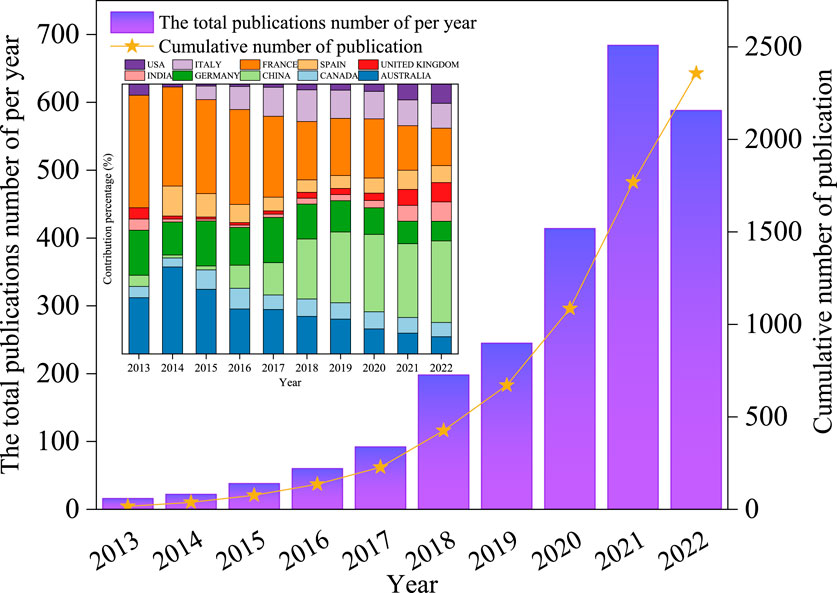
FIGURE 1. Number of publications per year and cumulative number of publications (Inset: Annual contribution of the top ten countries in terms of total number of publications between 2013 and 2022).
The inset of Figure 1 shows the number of articles published each year by the top 10 countries or regions in terms of the total number of articles published that year. In 2013 and 2014, United Kingdom, Australia and the United States almost all ranked in the top three, contributing significantly to the research on marine MP pollution control. Also, it is worth noting that the number of articles from China has increased tremendously after 2016. After 2019, the number of articles from Chinese researchers has steadily exceeded 28%, which indicates that Chinese researchers have been actively involved in research on marine MP pollution control for several years and have achieved considerable results.
3.2 Source journal analysis
Journals have vital importance in scholarly communication and the dissemination of scientific discoveries. By conducting a journal analysis, we were able to identify influential journals within the field. Table 1 lists the top 10 prolific journals that published more than 30 articles related to the control of MP pollution in the ocean, and they are all included in SCI/SCIE.
Science of the Total Environment (Sci. Total Environ.) is an international journal for publication of original research on the total environment, which includes the atmosphere, hydrosphere, biosphere, lithosphere, and anthroposphere. With 303 papers, Sci. Total Environ. has published the largest number of papers on marine MP pollution control studies, accounting for about 25.72%. The second-ranked journal is Marine Pollution Bulletin (Mar. Pollut. Bull., 293 papers, accounting for 24.87%), which focuses on the rational use of marine resources in estuaries, oceans and seas, as well as the documentation of marine pollution and the introduction of new forms of measurement and analysis. It deals not only with sewage treatment and pollution control but also with the management, economic aspects, and protection of the marine environment in general. The third-ranked one is Environmental Pollution (Environ. Pollut., 215 papers, accounting for 18.25%), which covers all aspects of environmental pollution and mitigation measures related to ecosystems and human health. Other core journals have also focused on the sources, distribution, biological effects and toxicity of marine MP pollution. These journals provide scholars with an important scientific basis for in-depth studies on the effects and control of marine MP pollution.
3.3 Author contribution and collaboration
3.3.1 Author characteristics
The bibliometric analysis identified authors who contributed to specific areas of research and their collaborative relationships. (Kholidah et al., 2022). A total of 10,074 authors were involved in marine MP pollution control studies during the period 2013–2022, according to the conditions in “2.1 Data collection.” As shown in Figure 2A, the size of the circles indicates the number of publications, with Chelsea M. Rochman from the University of Toronto, Canada, publishing the highest, with a number of 18 papers. Richard C. Thompson from the University of Plymouth (United Kingdom), Huahong Shi from East China Normal University (China), and Teresa Rocha-Santos from Universidade de Aveiro (Portugal) ranked second, each one with 17 articles. The total link strength (TLS) obtained from VOSviewer can effectively reveal the relationship between the number and frequency of co-authors. Different colors represent different clusters of author collaborations. The radiation intensity of the author clusters represents the collaboration between them, as shown in Figure 2B, the redder the color, the closer the collaboration between the authors. The results in Figure 2 show that several clusters of authors with close collaboration emerge, such as Teresa Rocha-Santos, Chelsea M. Rochman and Richard C. Thompson. International cooperation in this area is currently not strong enough, given the links between the different clusters.
3.3.2 The most productive and influential institutions
An analysis of organizational collaboration reveals information on the most influential and productive institutions. To further identify the leading institutions, Table 2 lists the top 10 institutions with the highest number of publications. Among these institutions, the top three are from China, while the fourth and fifth are from Portugal and the United Kingdom, respectively. Figure 3 shows the knowledge domain graph of the collaborating institutions using VOSviewer, where each node represents an institution and the size of the node indicates the number of published papers. The link between two nodes indicates the collaboration between institutions, and the larger the link width, the larger the link width means the closer the collaboration between institutions. Different colors represent different clusters of institutional collaboration. Chinese Academy of Science has the highest production of publications and the top-ranked TLS, indicating a broader collaboration and greater academic influence. In addition, the results in Figure 3 show that the two institutions with the closest collaboration are the Chinese Academy of Sciences and the University of Chinese Academy of Sciences, and the second are the University of Exeter Fremer and Plymouth Marine Laboratory.
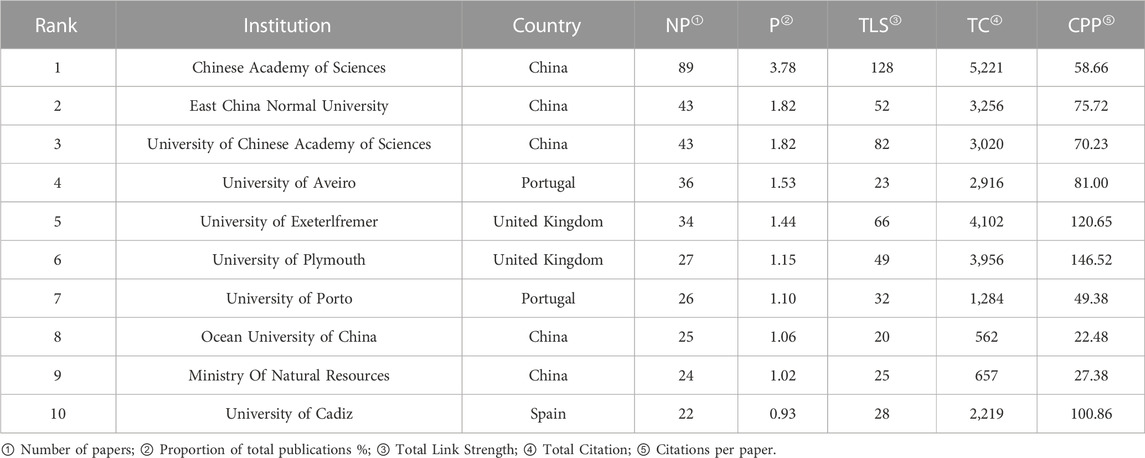
TABLE 2. Top 10 institutions with the most publications in the field of marine MP pollution control research.
3.3.3 The most productive and influential countries/territories
In order to analyze the cooperation among the countries/regions involved in the study of this theme, the distribution of countries/regions was analyzed. As many as 116 countries/regions were involved in this theme study, and 66 countries/regions published more than five articles. The top five countries/regions were China, the United States, the United Kingdom, Italy, and India, with 548 (23.25%), 301 (12.77%), 235 (9.97%), 202 (8.57%), and 176 (7.47%) publications, respectively. The map of knowledge areas for co-authored countries/regions is shown in Figure 4. The nodes on the map represent different countries/regions, and their sizes represent the number of publications. The link between two nodes implies that they have a collaborative relationship and the denser the link line, the closer the collaboration between the two countries/regions. The United States, UK, China, Australia, Germany, Canada, France and Italy are the countries with closer cooperation with the other countries. China and the United States have the closest cooperation, followed by Australia-UK, and United States-Canada.
3.4 Co-citation analysis
The co-citation analysis is based on an understanding of the relationship between reference lists and co-citation aspects, and can be used effectively to disclose relationships between scholarly publications or works in various fields of study. (Osareh, 1996) Since scientific literature is generated by citing earlier scholarly work, citation networks provide evidence of the knowledge base of a knowledge domain. Journal co-citation and article co-citation analyses were used in this study because they help explore structure, dynamics, and paradigm development. (Liu et al., 2015).
3.4.1 Journal co-citation analysis
The knowledge domain of journal co-citation mapping in the field of marine MP pollution control research is shown in Figure 5. Two different journals are connected by connecting lines, indicating that two articles published in different journals are cited in the same article (later published). The denser the connecting lines, the higher the co-citation intensity of these two journals.
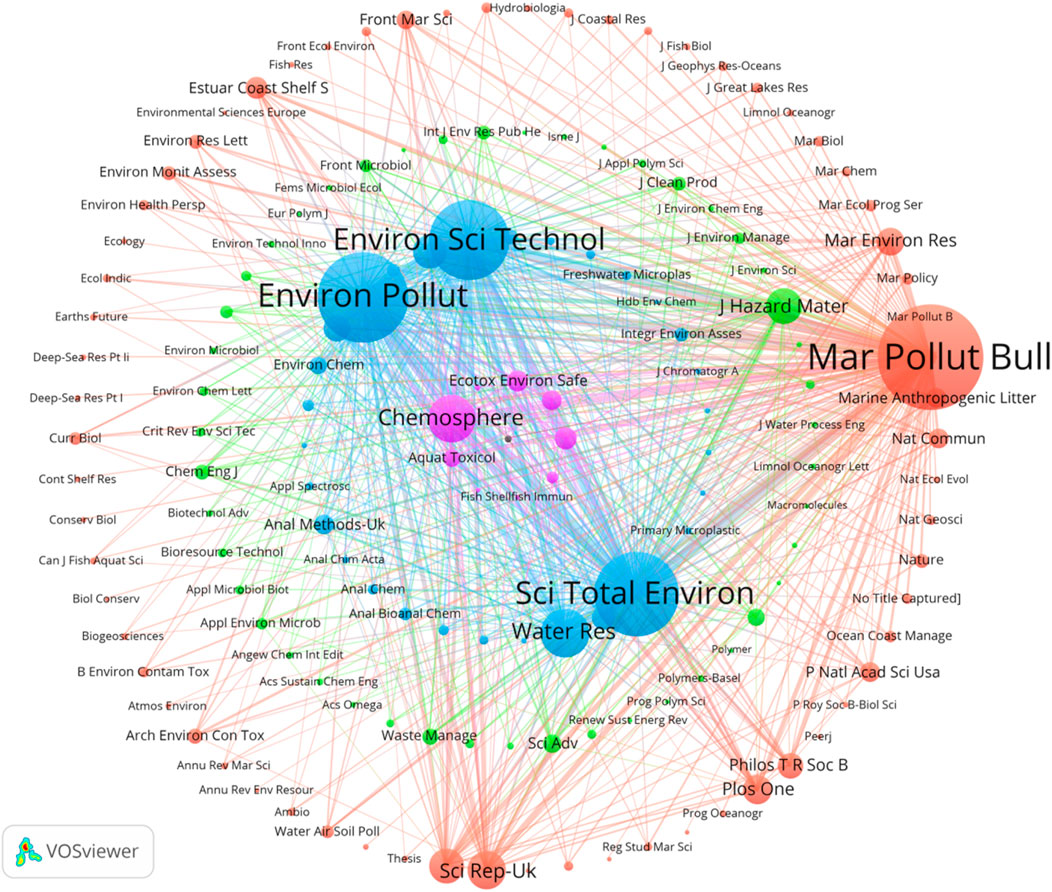
FIGURE 5. Graphical representation of journal co-citation knowledge domains in the field of marine MP pollution control.
The blue color in Figure 5 is mainly focused on the engineering and technology area of environmental pollution and mitigation measures related to ecosystems and human health, represented by Environ. Sci. Technol., Environ. Pollut. and Sci. Total Environ. journals. In terms of co-citation intensity, they have a close co-citation relationship with other journals. The green cluster mainly covers journals related to materials chemistry science, including J. Hazard. Mater., Angewandte Chemie-Internationa Edition (Angew. Chem. Int. Edit.), and Polym Degrad Stabil (Polym. Degrad. Stab.). The purple cluster, led by Chemosphere focuses on the scientific knowledge of environmental chemistry and toxicology.
From Figure 5, Mar. Pollut. Bull. is the largest node among all journals, indicating that it is the most cited journal along with other journals. Mar. Pollut. Bull. has a higher influence in the MP marine pollution research, which is not only related to the influence of the journal but also to the number of articles published in the journal; Mar. Pollut. Bull. has only 10 publications (293) less than Sci. Total Environ., the one with the largest number of publications on the MP topic. In the blue cluster, Environ. Pollut., Environmental Science & Technology (Environ. Sci. Technol.) and Sci. Total Environ. were also widely cited, indicating that journals related to environmental governance research generally have a broader reach. In addition, the connecting lines between the four journals mentioned above are thicker than the other connecting lines, indicating a higher frequency of co-citations between these four journals.
In summary, the main research aspects of marine microplastic pollution control include environmental pollution engineering and technology, materials chemistry, environmental chemistry and toxicology. These research streams work together to provide the scientific basis and technical support for the comprehension, monitoring and control of marine microplastic pollution.
3.4.2 Literature co-citation analysis
Top 20 most influential papers in the field of marine MP pollution control research, in terms of co-citations are listed in Table 3. The top 20 highly cited papers, 16 of which were published after 2010, indicate that the field has evolved rapidly in the past decade or so, which is highly compatible with the scope of this paper (2013–2022). In terms of topics, four of the 20 papers are reviews of marine MP pollution, 10 are related to sources of marine MPs, three more are about the effects of marine MPs on marine organisms, and two are studies on the full life cycle of plastics and potential solutions to marine MP pollution. In addition, a paper on MP pollution in surface water of lakes is of interest.
The most cited paper was “Plastic waste inputs from land into the ocean” by Jenna R. Jambeck et al. (Jambeck et al., 2015) with 790 citations. This study estimated the mass of land-based plastic waste entering the ocean by linking data on global solid waste production, population density, and economic conditions. The size of the population and the quality of the waste control system largely determine which countries provide the most unrecovered waste that could become marine plastic litter. The proposed model in the article aims to calculate the order of magnitude of mismanaged plastic waste likely to flow into the global ocean based on the best available data at the time, in order to assess the factors that determine the largest sources of mismanaged plastic waste. To curb the growth of plastic pollutants, it is critical to reduce waste and improve “downstream” waste management strategies, such as improving waste management infrastructure, expanding recycling systems, and expanding producer responsibility.
“Microplastics in the marine environment” was the second most cited paper with 786 citations. This review discusses the mechanisms of generation and the potential impacts of MPs in the ocean environment. The main mechanism of MP production is related to plastic breakage and surface embrittlement due to weathering in the beach environment. MPs and nanoplastics readily absorb and concentrate persistent organic pollutants (POPs), and MP particles containing POPs can be ingested by marine plankton, which cause toxic transfer and accumulation through the biological food chain, ultimately having serious and far-reaching impacts on marine ecosystems. (Andrady, 2011). The third-ranked article is “Microplastics as contaminants in the marine environment: a review” (692 citations), which provides an overview of the nature, nomenclature, and sources of MPs; in addition to exploring the pathways by which MPs enter the marine environment, determining spatial and temporal trends in MP abundance, and identifying their environmental impacts. The article also briefly assesses methods for detecting MPs in the marine environment, which include 1) beach combing; 2) sediment sampling; 3) ocean trawling; 4) ocean observational measurements; and 5) biological sampling. (Cole et al., 2011) The fourth-ranked article “Microplastics in the Marine Environment: A Review of the Methods Used for Identification and Quantification” (606 citations) comparatively analyzed 68 research articles through five aspects: 1) research objectives, 2) sampling procedures, 3) laboratory processing of samples, 4) identification of microplastics, and 5) microplastic abundance. Three main sampling strategies were identified: selective sampling, volume reduction sampling, and batch sampling. Basic criteria and methods are recommended to ensure comparable quantitative estimates in the future, and this work contributes to the establishment of standardized sampling procedures that provide a more comprehensive understanding of the sources, sinks, and fluxes of MPs in the marine environment (Hidalgo-Ruz et al., 2012).
As can be seen in Table 3, marine MPs have attracted great attention in terms of sources and quantification approaches due to their specific environmental and pollution transmission capabilities. Among them, freshwater and municipal wastewater treatment plant discharges are marine sources, and MPs in freshwater systems, (Eerkes-Medrano et al., 2015) such as lakes (Eriksen et al., 2013), rivers (Lebreton et al., 2017) and wastewater treatment plants (Carr et al., 2016; Murphy et al., 2016), are also gradually attracting attention.
3.5 Keywords co-occurrence analysis
The purpose of keyword co-occurrence analysis is to study the core content and structure of a particular field and thus reveal the research frontiers in the field. As can be seen from the results in Figure 6, five clusters were obtained by the analysis software, where a node represents a keyword, the size of the node represents the frequency of that keyword, and the density of connecting lines between nodes represents the intensity of co-occurrence between keywords.
Cluster 1 (red): the most frequent keyword in the red cluster is “Microplastics,” in Figure 6, which is connected to more than thirty percent of the nodes. Other major nodes in the red cluster are “Polystyrene Microplastics,” “Polyethylene,” “Toxicity,” etc., An assessment of MP contamination around the island of Mauritius in the South West Indian Ocean (SWIO) region found that blue MP was the most common type of MP and polyethylene was the most common type of polymer. (Mattan-Moorgawa et al., 2021). The composition and pollutability of MPs and the harm caused to marine organisms by further formation of POPs through bioconcentration are the main studies. Ingestion of MPs by marine microorganisms can affect their movement, feeding, mating, and mechanical reception, which may limit their ability to detect prey, feed, reproduce, and evade predators. (Cole et al., 2013). Cluster 2 (yellow) has a good correlation between “Pollution”, “Plastic Debris” and “Accumulation” among 153 keywords, which are also some of the largest nodes in the red cluster. This cluster concentrates on the study of plastic debris accumulation behavior on the seafloor, beaches, and bays. Cluster 3 (green) mainly includes “Marine-Environment,” “Water Treatment Plants,” “Waste-Water” and “Fibers,” etc., A detailed understanding of the sources of marine MPs is an important prerequisite for mitigating marine MP pollution, and the discharge of sewage treatment plants in coastal cities is one of the important sources to seawater, and the MP content in discharged wastewater has an important impact on the marine environment. Not only wastewater treatment plant drainage but also freshwater systems in the mainland are important sources of seawater. (Jiajia et al., 2018). Cluster 4 (purple) includes “Sediments,” “Abundance,” and “Surface Waters.” WANG et al. analyzed MPs in freshwater rivers, such as the Yellow River, Three Gorges Reservoir and Pearl River in China, to investigate the difference between the presence of MPs in freshwater, and the impact on the abundance of marine MPs. Improving the understanding of the sources and sinks of MPs in the marine environment through their pathways to the ocean is important for reducing MP pollution. (Browne et al., 2011). In addition, a regional understanding of the abundance, distribution, and composition of beach litter is fundamental for developing strategies to manage litter pollution in specific areas. (Nelms et al., 2020). The main nodes of cluster 5 (blue) are “Sea,” “Ingestion,” “Contamination,” “Fish” and “Zooplankton.” There is evidence that MPs can be ingested by fish, shellfish, etc., and absorbed and stored by their tissues and cells, leading to a negative impact on the health of marine organisms through bioconcentration, which in turn has a profound impact on marine ecology (Bowmer and Kershaw, 2013).
3.6 Research frontier identification
In Figure 7, the x-axis shows the publication years from 2013 to 2022 and the y-axis shows the clustering of different keywords. A node represents a keyword, i.e., a larger node represents a stronger keyword, while the links between keywords indicate co-occurrence relationships with each other. (van Eck and Waltman, 2010) The Citespace software analysis produced a total of eight clusters: “marine debris,” “wastewater treatment plant,” “surface water,” “plastic ingestion,” “metals,” “marine environment,” “oxidative stress,” and “microparticles.” The timeline view clearly reflected the evolution of keywords under each representative cluster in the marine MP research literature over this period. (Seltenrich, 2015).
From 2013, the keywords that appear on the timeline include “marine environment,” “pollution,” “plastic debris,” etc., In 2014, the keywords include “sea,” “identification,” “water” and “fish.” In 2015, “degradation,” “surface water” and “micro plastic pollution” appeared. In 2021, keywords involved “polyethylene degradation” and “plastic litter”. In 2022, the keywords included “surface degradation feature,” “conservation,” “bacteria” and “bioaccumulation.”
As the highlighted keywords may reflect a sudden spike in the number of citations for a keyword over a period of time, it is possible to use CiteSpace to obtain a keyword highlighting graph to study research trends in marine microplastic control over time. As shown in Table 4 below, “plastic debris” has been a research buzzword from 2013 to 2020; “mytilus edulis,” “ingestion,” and “accumulation” are buzzwords that accompanied research on marine microplastics from 2013 to 2018. “synthetic fibres” was a research buzzword from 2018 to 2019; “toxic chemical” is a research hotspot from 2019 to 2020; “Pearl River” and “microplastic ingestion” are research hotspots from 2020 to 2022, while “ingestion” was previously looked at from 2013 to 2017. The persistence of the terms “Pearl River” and “microplastic ingestion” up to the present indicates that they are the dominant trend in research on the control of marine MPs.
4 Conclusion
A bibliometric analysis of published papers related to marine MP pollution control in the WOS core database between 2013 and 2022 was conducted to obtain a knowledge map through information visualization analysis. So far, the characteristics of marine MP control research are as follows, with research in this area showing initial growth between 2015 and 2017 and rapid development after 2018. China has emerged as the most active country, with research spanning environmental science, marine science, engineering and materials. However, there is room for greater global collaboration, as research in some countries appears to be relatively independent. Key research hotspots include quantification, traceability, contaminability and control strategies for MP. In addition, surface water, municipal wastewater and freshwater with MP contamination were identified as important research topics. The oxidative stress response of marine organisms to MPs and the impact of surface waters are at the forefront of marine MP pollution control research, which is multi-faceted and focuses not only on marine pollution management but also on reducing MP production at source.
This study provides some guidance for the control of marine MP pollution. It identifies research hotspots and frontiers, allowing for more focused resource allocation and more effective problem-solving. It can facilitate international collaboration and knowledge sharing through partnerships between authors and countries. Collaboration facilitates the exchange of information, technology transfer and sharing of experiences, thereby enhancing global cooperation in the management of marine MP pollution. By analyzing the relevance and co-citation relationships of journals, influential research publishing platforms can be identified, increasing impact and visibility. It can also provide insights to guide the development of policy and management strategies for effective regulation.
Existing policies and measures focus on reducing plastic waste emissions and increasing plastic recycling rates, but this does not fully address the problem of marine litter. Future research needs to focus on policy implications and technological innovation. Scientific and technological innovation is needed to strengthen scientific research on marine MP pollution, to carry out ecological risk assessments of MP, to find efficient removal technologies, to overcome difficulties in switching to recyclable and degradable materials, etc., to develop and promote alternatives to plastics, and to change production and consumption patterns. Of course, the above is also relevant to guide the management of MP pollution in freshwater, which is becoming a popular research topic.
Author contributions
XL: investigation, data curation, formal analysis, writing-original draft. YS: data curation, investigation. CF: validation, data curation, supervision. YT: data curation. DH: investigation, data curation, resources. YG: funding acquisition, supervision. All authors contributed to the article and approved the submitted version.
Funding
This work was financially supported by the Central-Public interest Scientific Institution Basal Research Fund (2019T13, 2019T14). YG also appreciates Natural Science Foundation of China (52270129), Shanghai Natural Science Foundation (20ZR1421100) and Science and Technology Development Fund of Pudong New Area (PKJ2021-C01, PKJ2022-C07).
Conflict of interest
The authors declare that they have no known competing financial interests or personal relationships that could have appeared to influence the work reported in this paper.
Publisher’s note
All claims expressed in this article are solely those of the authors and do not necessarily represent those of their affiliated organizations, or those of the publisher, the editors and the reviewers. Any product that may be evaluated in this article, or claim that may be made by its manufacturer, is not guaranteed or endorsed by the publisher.
References
Agamuthu, P., Mehran, S. B., Norkhairah, A., and Norkhairiyah, A. (2019). Marine debris: A review of impacts and global initiatives. Waste Manag. Res. J. Int. Solid Wastes Public Clean. Assoc. ISWA 37, 987–1002. doi:10.1177/0734242x19845041
Andrady, A. L. (2011). Microplastics in the marine environment. Mar. Pollut. Bull. 62, 1596–1605. doi:10.1016/j.marpolbul.2011.05.030
Auta, H. S., Emenike, C. U., and Fauziah, S. H. (2017). Distribution and importance of microplastics in the marine environment: A review of the sources, fate, effects, and potential solutions. Environ. Int. 102, 165–176. doi:10.1016/j.envint.2017.02.013
Barnes, D. K., Galgani, F., Thompson, R. C., and Barlaz, M. (2009). Accumulation and fragmentation of plastic debris in global environments. Philos. Trans. R. Soc. Lond B Biol. Sci. 364, 1985–1998. doi:10.1098/rstb.2008.0205
Basili, M., Quero, G. M., Giovannelli, D., Manini, E., Luna, G. M., Avio, C. G., et al. (2020). Major role of surrounding environment in shaping biofilm community composition on marine plastic debris. Front. Mar. Sci. 7, 262. doi:10.3389/fmars.2020.00262
Bowmer, T., and Kershaw, P. (2013). “Proceedings of the GESAMP international workshop on microplastic particles as a vector in transporting persistent, bio-accumulating and toxic substances in the ocean, 28-30th june 2010,” in UNESCO-IOC (Paris: Gesamp Reports & Studies).
Browne, M. A., Crump, P., Niven, S. J., Teuten, E., Tonkin, A., Galloway, T., et al. (2011). Accumulation of microplastic on shorelines woldwide: Sources and sinks. Environ. Sci. Technol. 45, 9175–9179. doi:10.1021/es201811s
Carr, S. A., Liu, J., and Tesoro, A. G. (2016). Transport and fate of microplastic particles in wastewater treatment plants. Water Res. 91, 174–182. doi:10.1016/j.watres.2016.01.002
Castaeda, R. A., Avlijas, S., Simard, M. A., and Ricciardi, A. (2014). Microplastic pollution in st. Lawrence river sediments. Can. J. Fish. Aquatic Sci. 71, 21–40. doi:10.1139/cjfas-2014-0281
Chen, C. (2006). CiteSpace II: Detecting and visualizing emerging trends and transient patterns in scientific literature. J. Am. Soc. Inf. Sci. Technol. 57, 359–377. doi:10.1002/asi.20317
Cole, M., Lindeque, P., Fileman, E., Halsband, C., Goodhead, R., Moger, J., et al. (2013). Microplastic ingestion by zooplankton. Environ. Sci. Technol. 47, 6646–6655. doi:10.1021/es400663f
Cole, M., Lindeque, P., Halsband, C., and Galloway, T. S. (2011). Microplastics as contaminants in the marine environment: A review. Mar. Pollut. Bull. 62, 2588–2597. doi:10.1016/j.marpolbul.2011.09.025
Cozar, A., Echevarria, F., Gonzalez-Gordillo, J. I., Irigoien, X., Ubeda, B., Hernandez-Leon, S., et al. (2014). Plastic debris in the open ocean. Proc. Natl. Acad. Sci. U. S. A. 111, 10239–10244. doi:10.1073/pnas.1314705111
Derraik, J. G. (2002). The pollution of the marine environment by plastic debris: A review. Mar. Pollut. Bull. 44, 842–852. doi:10.1016/s0025-326x(02)00220-5
Eerkes-Medrano, D., Thompson, R. C., and Aldridge, D. C. (2015). Microplastics in freshwater systems: A review of the emerging threats, identification of knowledge gaps and prioritisation of research needs. Water Res. 75, 63–82. doi:10.1016/j.watres.2015.02.012
Eriksen, M., Lebreton, L. C., Carson, H. S., Thiel, M., Moore, C. J., Borerro, J. C., et al. (2014). Plastic pollution in the world's oceans: More than 5 trillion plastic pieces weighing over 250,000 tons afloat at sea. PLoS One 9, e111913. doi:10.1371/journal.pone.0111913
Eriksen, M., Mason, S., Wilson, S., Box, C., Zellers, A., Edwards, W., et al. (2013). Microplastic pollution in the surface waters of the laurentian great lakes. Mar. Pollut. Bull. 77, 177–182. doi:10.1016/j.marpolbul.2013.10.007
Geyer, R., Jambeck, J. R., and Law, K. L. (2017). Production, use, and fate of all plastics ever made. Sci. Adv. 3, e1700782. doi:10.1126/sciadv.1700782
Hidalgo-Ruz, V., Gutow, L., Thompson, R. C., and Thiel, M. (2012). Microplastics in the marine environment: A review of the methods used for identification and quantification. Environ. Sci. Technol. 46, 3060–3075. doi:10.1021/es2031505
Irene Samy Fahim, D. G., and Landrigan., P. (2021). From pollution to solution: a global assessment of marine litter and plastic pollution (Nairobi: United Nations Environment Programme).
Jambeck, J. R., Geyer, R., Wilcox, C., Siegler, T. R., Perryman, M., Andrady, A., et al. (2015). Plastic waste inputs from land into the ocean. Sci. (New York, N.Y.) 347, 768–771. doi:10.1126/science.1260352
Jiajia, A., Wang, L., and Zheng, J. (2018). A critical review on the sources and instruments of marine microplastics and prospects on the relevant management in China. Waste Manag. Res. J. Int. Solid Wastes Public Clean. Assoc. Iswa 36, 898–911. doi:10.1177/0734242x18793504
Kholidah, H., Hijriah, H. Y., Mawardi, I., Huda, N., Herianingrum, S., and Alkausar, B. (2022). A Bibliometric mapping of peer-to-peer lending research based on economic and business perspective. Heliyon 8, e11512. doi:10.1016/j.heliyon.2022.e11512
Law, K. L. (2017). Plastics in the marine environment. Annu. Rev. Mar. Sci. 9, 205–229. doi:10.1146/annurev-marine-010816-060409
Lebreton, L. C. M., van der Zwet, J., Damsteeg, J. W., Slat, B., Andrady, A., and Reisser, J. (2017). River plastic emissions to the world's oceans. Nat. Commun. 8, 15611. doi:10.1038/ncomms15611
Liu, Z., Yin, Y., Liu, W., and Dunford, M. (2015). Visualizing the intellectual structure and evolution of innovation systems research: A bibliometric analysis. Scientometrics 103, 135–158. doi:10.1007/s11192-014-1517-y
Lönnstedt, O. M., and Eklöv, P. (2016). Retracted: Environmentally relevant concentrations of microplastic particles influence larval fish ecology. Sci. (New York, N.Y.) 352, 1213–1216. doi:10.1126/science.aad8828
Lusher, A. L., McHugh, M., and Thompson, R. C. (2013). Occurrence of microplastics in the gastrointestinal tract of pelagic and demersal fish from the English Channel. Mar. Pollut. Bull. 67, 94–99. doi:10.1016/j.marpolbul.2012.11.028
Mattan-Moorgawa, S., Chockalingum, J., and Appadoo, C. (2021). A first assessment of marine meso-litter and microplastics on beaches: Where does Mauritius stand? Mar. Pollut. Bull. 173, 112941. doi:10.1016/j.marpolbul.2021.112941
Murphy, F., Ewins, C., Carbonnier, F., and Quinn, B. (2016). Wastewater treatment works (WwTW) as a source of microplastics in the aquatic environment. Environ. Sci. Technol. 50, 5800–5808. doi:10.1021/acs.est.5b05416
Napper, I. E., Bakir, A., Rowland, S. J., and Thompson, R. C. (2017). Characterization, quantity, and sorptive properties of microplastics extracted from cosmetics. Fate Impact Microplastics Mar. Ecosyst. 2017, 63–64. doi:10.1016/B978-0-12-812271-6.00060-0
Nelms, S. E., Eyles, L., Godley, B. J., Richardson, P. B., Selley, H., Solandt, J. L., et al. (2020). Investigating the distribution and regional occurrence of anthropogenic litter in English marine protected areas using 25 years of citizen-science beach clean data. Environ. Pollut. 263, 114365. doi:10.1016/j.envpol.2020.114365
Osareh, F. (1996). Bibliometrics, citation analysis and Co-citation analysis: A review of literature I. Libri 46. doi:10.1515/libr.1996.46.3.149
Pan, X., Yan, E., Cui, M., and Hua, W. (2018). Examining the usage, citation, and diffusion patterns of bibliometric mapping software: A comparative study of three tools. J. Inf. 12, 481–493. doi:10.1016/j.joi.2018.03.005
Salvador Cesa, F., Turra, A., and Baruque-Ramos, J. (2017). Synthetic fibers as microplastics in the marine environment: A review from textile perspective with a focus on domestic washings. Sci. Total Environ. 598, 1116–1129. doi:10.1016/j.scitotenv.2017.04.172
Seltenrich, N. (2015). New link in the food chain? Marine plastic pollution and seafood safety. Environ. Health Perspect. 123, A34–A41. doi:10.1289/ehp.123-A34
Shiffrin, R. M., and Boerner, K. (2004). Mapping knowledge domains. Proc. Natl. Acad. Sci. U. S. A. 101, 5183–5185. doi:10.1073/pnas.0307852100
Shim, W. J., Hong, S. H., and Eo, S. (2018). “Chapter 1 - marine microplastics: Abundance, distribution, and composition,” in Microplastic contamination in aquatic environments. Editor E. Y. Zeng (Elsevier), 1–26. doi:10.1016/B978-0-12-813747-5.00001-1
Tanaka, K., Takada, H., Yamashita, R., Mizukawa, K., Fukuwaka, M. A., and Watanuki, Y. (2013). Accumulation of plastic-derived chemicals in tissues of seabirds ingesting marine plastics. Mar. Pollut. Bull. 69, 219–222. doi:10.1016/j.marpolbul.2012.12.010
Teuten, E. L., Saquing, J. M., Knappe, D. R., Barlaz, M. A., Jonsson, S., Bjorn, A., et al. (2009). Transport and release of chemicals from plastics to the environment and to wildlife. Philos. Trans. R. Soc. Lond B Biol. Sci. 364, 2027–2045. doi:10.1098/rstb.2008.0284
Thompson, R. C., Olsen, Y., Mitchell, R. P., Davis, A., Rowland, S. J., John, A. W. G., et al. (2004). Lost at sea: Where is all the plastic? Sci. (New York, N.Y.) 304, 838. doi:10.1126/science.1094559
van Eck, N. J., and Waltman, L. (2010). Software survey: VOSviewer, a computer program for bibliometric mapping. Scientometrics 84, 523–538. doi:10.1007/s11192-009-0146-3
Wieczorek, A. M., Croot, P. L., Lombard, F., Sheahan, J. N., and Doyle, T. K. (2019). Microplastic ingestion by gelatinous zooplankton may lower efficiency of the biological pump. Environ. Sci. Technol. 53, 5387–5395. doi:10.1021/acs.est.8b07174
Wright, S. L., Thompson, R. C., and Galloway, T. S. (2013). The physical impacts of microplastics on marine organisms: A review. Environ. Pollut. 178, 483–492. doi:10.1016/j.envpol.2013.02.031
Xanthos, D., and Walker, T. R. (2017). International policies to reduce plastic marine pollution from single-use plastics (plastic bags and microbeads): A review. Mar. Pollut. Bull. 118, 17–26. doi:10.1016/j.marpolbul.2017.02.048
Keywords: marine environment, microplastics, pollution control, bibliometric analysis, visualization software
Citation: Lou X, Sui Y, Fang C, Tang Y, Huang D and Guo Y (2023) Bibliometric analysis for global marine microplastic pollution control from 2013 to 2022. Front. Environ. Sci. 11:1215317. doi: 10.3389/fenvs.2023.1215317
Received: 01 May 2023; Accepted: 27 September 2023;
Published: 09 October 2023.
Edited by:
Nsikak U. Benson, Université Claude Bernard Lyon 1, FranceReviewed by:
Andreia C. M. Rodrigues, University of Aveiro, PortugalElena Sezenna, Polytechnic University of Milan, Italy
Mohamed Mohsen, Jimei University, China
Copyright © 2023 Lou, Sui, Fang, Tang, Huang and Guo. This is an open-access article distributed under the terms of the Creative Commons Attribution License (CC BY). The use, distribution or reproduction in other forums is permitted, provided the original author(s) and the copyright owner(s) are credited and that the original publication in this journal is cited, in accordance with accepted academic practice. No use, distribution or reproduction is permitted which does not comply with these terms.
*Correspondence: Changling Fang, ZmFuZ2xpbmcwMzM0MDgxQDE2My5jb20=; Yaoguang Guo, eWdndW9Ac3NwdS5lZHUuY24=
 Xiaoyi Lou1
Xiaoyi Lou1 Changling Fang
Changling Fang Yaoguang Guo
Yaoguang Guo